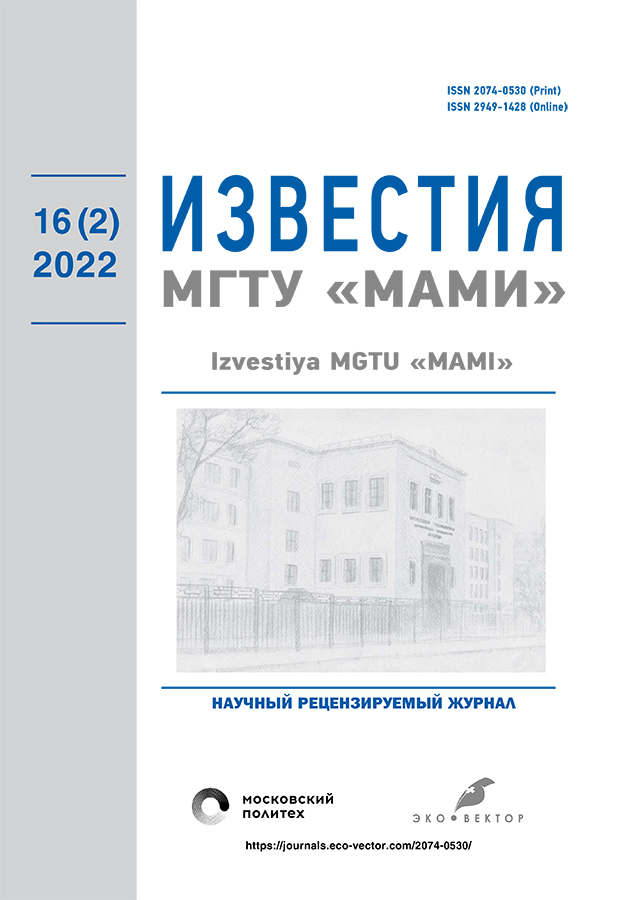On calculational analysis of suspensions with hydraulic springs
- Authors: Nakaznoy O.A.1, Tsipilev A.A.1
-
Affiliations:
- Bauman Moscow State Technical University
- Issue: Vol 16, No 2 (2022)
- Pages: 135-148
- Section: Hydraulic and pneumatic systems
- URL: https://journals.eco-vector.com/2074-0530/article/view/105257
- DOI: https://doi.org/10.17816/2074-0530-105257
- ID: 105257
Cite item
Abstract
BACKGROUND: The information about application of hydraulic springs in suspension systems of tanks and self-propelled artillery weapons may be found in domestic scientific and nonfiction literature. In addition, machines, which prototypes were equipped with this type of suspension, are known. For instance, possibility of hydraulic suspension implementation was proven on the T-34 tank prorotype, whereas application of this type of suspension with heavy tanks gave the most prospectivity. Complication of sealing build-up with sufficient life span, development of technologies of metal springs strengthening and shutdown of heavy tanks development did not allowed hydraulic suspensions to become widespread. At present, they are not used at all, whereas methods of analytical calculation are not in public access, despite of the interest of a group of scientists.
AIMS: Development of the method of determination of main parameters of suspensions with hydraulic springs and analysis of properties of the T-34-76 Soviet middle tank prototype hydraulic suspension from the point of modern theory of nonlinear suspension systems.
METHODS: Justification and confidence of given dependencies for properties calculation, conclusions and recommendations are confirmed with application of strict mathematical apparatus of mechanics, hydraulics and thermodynamics as well as scientifically justified theoretical backgrounds.
RESULTS: Historic data on liquids compressibility researches, method of analytical determination of main properties of hydraulic springs with various design schemes, allowing restoring of properties of suspensions of existing tracked vehicles, synthesizing properties of other suspensions and, moreover, estimating reasonability of properties of suspension with hydraulic springs, are presented in the article. According to the method, proposed in the article, properties of the hydraulic spring from the T-34-76 Soviet middle tank prototype, equipped with hydraulic suspension, were restored and analyzed. In addition, suspension properties for the same vehicle were synthesized and used for a comparative analysis.
CONCLUSIONS: The information, presented in the article, is helpful for research engineers, interested in study of elastic behavior of liquids in case of their application in suspension systems, whereas the proposed method, allowing synthesis of reasonable properties of hydraulic springs, gives an opportunity to study the ride comfort of tank propotypes, equipped with hydraulic suspension, with a good quality and, moreover, to synthesize hydraulic springs properties according to the demands, given to a design engineer.
Full Text
About the authors
Oleg A. Nakaznoy
Bauman Moscow State Technical University
Email: nakaznoi@gmail.com
ORCID iD: 0000-0003-4029-2434
SPIN-code: 9767-0435
Professor, Dr. Sci. (Tech.)
Russian Federation, MoscowAlexander A. Tsipilev
Bauman Moscow State Technical University
Author for correspondence.
Email: alexts@bmstu.ru
ORCID iD: 0000-0002-5764-0506
SPIN-code: 3877-2736
Cand. Sci. (Tech.), Associate Professor
Russian Federation, MoscowReferences
- Khramov YuA. Kanton D. Fiziki: Biograficheskii spravochnik. Akhiezera AI editor. Moscow: Nauka; 1983. (In Russ).
- Amagat EH. Memoires sur l’elasticite et la dilatabilite des fluides jusqu’aux tres hautes pressions. In: Annales de Chimie et de Physique. Vol. 29. Paris: Gauthier-Villars et fils; 1893:505–574. (In Fr).
- Vereshchagin LF, Zubkov VM. Zhidkosti, kak rabochie tela uprugikh elementov podvesok tankov. Vestnik tankovoi promyshlennosti. 1956;(3):1–34. (In Russ).
- Bridgman PW. The Thermodynamics of Electrical Phenomena in Metals, and A Condensed Collection of Thermodynamic Formulas. New York: Dover Publications; 1961.
- Lorents GA, Gintsburg ME, Astakhov KV. Lektsii po termodinamike. Izhevsk: Regulyarnaya i khaoticheskaya dinamika; 2001. (In Russ).
- Izuchenie szhimaemosti spetsial’nykh zhidkostei: Otchet po NIR (zaklyuchit.). Moscow: IOKh AN SSSR. Laboratoriya sverkhvysokikh davlenii; 1954.
- Shereshevskii AI, Unanyants TP, Bakharovskii GYa. Khimicheskie tovary. Spravochnik. Chast’ 1. Moscow: Gos-khimizdat; 1961. (In Russ).
- Tait PG. Report on some physical properties of water. Cambridge: University Press; 1888.
- Baybakov OV, Bashta TM, Kirillovskiy YuL, et al. Gidravlika, gidromashiny i gidroprivody. Uchebnik dlya mashinostroitel’nykh vuzov. Moscow: Mashinostroenie; 1982. (In Russ).
- Rakhmanov NN, Razin GM. Opytnaya gidravlicheskaya podveska na tanke T-34. Vestnik tankovoi promyshlennosti. 1953;(4):19–26. (In Russ).
- Teoriya i konstruktsiya tanka. Isakov PP editor. Moscow: Mashinostroenie; 1985. (In Russ).
- Dmitriev AA, Chobitok VA, Tel’minov AV. Teoriya i raschet nelineinykh sistem podressorivaniya gusenichnykh mashin. Moscow: Mashinostroenie; 1976. (In Russ).
- Nosov NA. Raschet i konstruirovanie gusenichnykh mashin. Leningrad: Mashinostroenie; 1972. (In Russ).
- Zimon AD. Adegziya zhidkosti i smachivanie. Moscow: Khimiya; 1974. (In Russ).
- Kotiev GO, Sarach EB. Kompleksnoe podressorivanie vysokopodvizhnykh dvukhzvennykh gusenichnykh mashin. Moscow: MGTU im. N.E. Baumana; 2010. (In Russ).
Supplementary files













